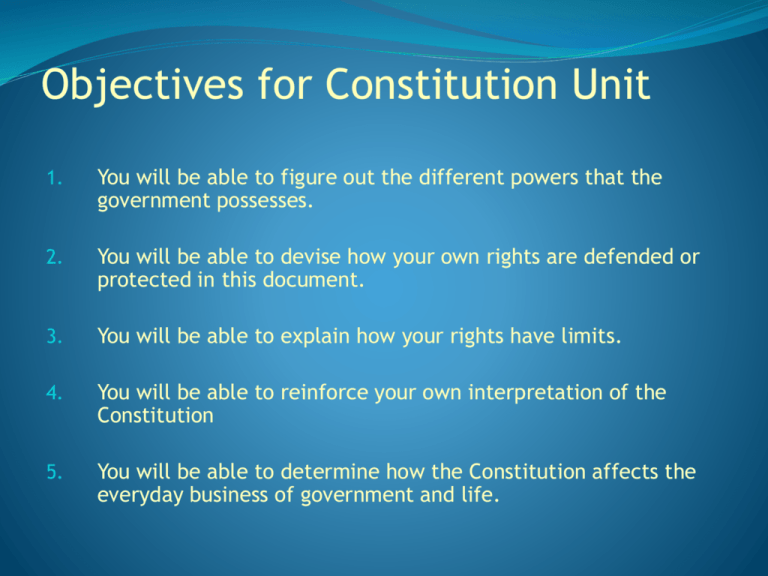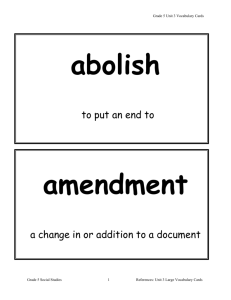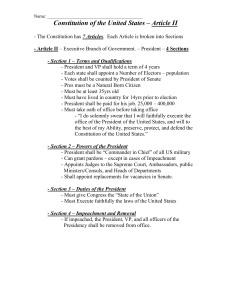House of Representatives
advertisement

Objectives for Constitution Unit 1. You will be able to figure out the different powers that the government possesses. 2. You will be able to devise how your own rights are defended or protected in this document. 3. You will be able to explain how your rights have limits. 4. You will be able to reinforce your own interpretation of the Constitution 5. You will be able to determine how the Constitution affects the everyday business of government and life. Some Loose Ends… Not everything about the Articles of Confederation was bad In 1785 the Congress got some of the states like Virginia, New York, and Massachusetts to give up their claims out west This was called the Land Ordinace of 1785 It also allowed for them to survey the land… more on the next slide Land Ordinances Other Things The reason for the ordinances was to encourage western land sales This was an easy way for the government to make some money A second ordinance, the Northwest Ordinance, organized the creation of new states It also abolished slavery within the territory – establishing a very important precedent Constitutional Convention Goal: revise the Articles of Confederation Key People: George Washington, James Madison, Alexander Hamilton, Ben Franklin Who wasn’t there?: John Adams, Thomas Jefferson, Patrick Henry – he thought something was up Why would some people be scared of this? What caused them to meet? Shays’ Rebellion showed that we needed some sort of national defense The national government had no way to make money – states paid dues each year, usually less than required There was no national trade policy – each state could do what it wanted Some people thought we were in danger of collapse Who was there? 55 delegates from 12 states – what state didn’t show up? Why would Rhode Island refuse to show up? Occupations: 32 Lawyers 11 Merchants 4 Politicians 2 Military Men 2 Doctors 2 Teachers 1 Inventor 1 Farmer Secrets, Secrets are no fun… While the state governments and the public knew that they were meeting, they had no idea what the delegates were discussing Here are some of the ‘rules’ 1. locked door to the room 2. closed shutters and windows (it was really hot) 3. no one was to speak in public about the proceedings 4. destroy records of proceedings (private notes were OK) Mr. Madison Madison was the most prepared guy in the room He wrote most of the ideas in the Constitution Although socially awkward, he dominated the Convention He also wrote the notes that gave us an idea of what happened during the Convention So we call him the “Father of the Constitution” Key Arguments: Representation: why would this be an issue? What did ‘revise’ really mean? Slavery: count them?, slave trade?, abolish it? State power: how to maintain it while building a stronger national government Virginia Plan Most of the Virginia delegates showed up early They used their time (well, Madison did) to prepare a new government Madison wrote it, but Edmund Randolph presented it on May 25 It shocked the room – why? What did it have? 3 branches of government: why would this be a good idea? Congress would be broken up into two houses: 1. Lower House – chosen by people in each state 2. Upper House – nominated by state legislature 3. representatives would be determined by population Congress would have power to regulate trade and taxes Congress could also veto a state law Who would like this plan? How does it balance state and national power? Uh oh… Delegates from smaller states were upset New Jersey delegate William Paterson presented his own plan aka the New Jersey Plan It was similar to the Virginia plan except that there would be one house of Congress, and it would have equal representation It still had 3 branches, the power to tax, the power to regulate commerce Problems Virginia and the larger states were worried about the NJ Plan – why? Hamilton then went up and spoke for six hours about his own plan for government: 1. bicameral legislature based on population 2. upper house was chosen by the lower house 3. upper house chose a President – who would serve for life People obviously didn’t like this, but it did present an opposite extreme to the NJ plan Connecticut Compromise Roger Sherman and Oliver Ellsworth presented a compromise: 1. two houses of legislature: a House of Representatives based on population, and a Senate with equal representation 2. the people would elect their representatives, and the Senate would be chosen by the state legislatures 3. every 3 slaves out of 5 would count towards the population Philosophical Basis for Compromise Mixed Government!! Every voice/class is heard Many examples in history of Mixed Government USA Exec = one Senate = few House = many England King = one Lords = few commons = many Rome Consul = one Senate = few Plebians = many The End Once the Great Compromise was proposed, most of the debate calmed down On Sept. 17, 1787 they approved the document Not everyone signed it – some feared the idea of not having individual rights protected The states would approve them individually – once 9 states approved it, the Constitution would be the law of the land Goals of the Constitution 1. Lay out a plan for our new government that would not be misinterpreted and would deal with long term issues 2. Prevent any one person from achieving power, which would lead to tyranny 3. In order to solve #2, they balanced the power across the three branches of government. 4. Lay out what the government can and cannot do. 5. Protect the rights of both individuals as well as states Fundamental Principles Checks and balances: ensures that each branch of the government watches over the others. An example of this would be impeachment Federalism: the idea that local, state, and national governments share responsibility over their respective areas, but that the national government has the most authority Separation of powers: each branch has it’s own job and they don’t overlap The Original Document Made up of 7 ‘articles,’ or sections that allude to a specific part of the government or issue No Bill of Rights- they came in 1791 Did not account for the future of slavery, in fact the words ‘slave’ and ‘slavery’ do not appear in the document The first three articles pertain to the three branches of government Legislative Branch What is the Legislative Branch? House of Representatives: 1. currently 435 members 2. representation based on state’s population 3. introduce any bill regarding spending 4. led by Speaker of the House Senate: 1. 2 Senators per state – why would this be important? 2. currently 100 members 3. originally chosen by State legislatures – why? 4. Vice President has tie breaking vote Key Jobs of the Legislative Branch Create laws Regulate taxes – hmm, but who always gets the blame? Approve any spending by the other branches Declare war Impeachment of officials Requirements for Office Senate: - 30 years old - citizen for 9 years - resident in the state you represent House: - 25 years old - citizen for 7 years - resident of the state you represent Powers of Congress 1. Raise and collect taxes: common federal tax laws 2. Regulate trade with other countries: why would this be important? 3. Regulate currency: what does this improve? 4. Declare war: why wouldn’t the President do this? 5. Pay for the armed forces 6. Approve any Presidential nominee 7. Allowed to create forts and other federal buildings in various states Other things 1. Habeas Corpus shall not be removed, except for rebellion 2. No taxes on exports 3. Must keep records of money spent, only money spent that is allowed by the budget 4. Impeachment of officials in the other branches- House of Reps 5. Trial for impeached official- Senate Structure of Legislative Branch Review Questions for Legislative Branch 1. How did this section reflect the ideas presented in the Virginia Plan, New Jersey Plan, and Connecticut Compromise? 2. How did this section reflect Whig ideology? 3. Did this section provide a balance of power between the states and the federal government? The White House: My future home What is the Executive Branch? • ‘executes’ or enforces the laws that Congress creates • Largest branch of the national government • Usually what people are complaining about • The President is in charge of it • Arguably has the most power of any branch of government How do you become President? Presidents are not directly elected by the people, instead they are chosen by the Electoral College In order to win, a President must gain a majority of the votes, which is now 270 If a candidate falls short, the House of Representatives will vote on who becomes the next President Five times (1800, 1824, 1876, 1888, and 2000), there was controversy regarding the outcome of the Electoral College What the Constitution Doesn’t Say It’s written with G Dubs in mind What to call the President… that came later What the role of the Vice President is… one Vice President, James Garner said it ‘wasn’t worth a bucket of warm spit’ If the President can simply fire his officials, it’s really unclear Until FDR, it didn’t say how many terms you could serve, just that you had 4 year terms GDubs established the precedent of leaving after two consecutive terms Requirements for Office, etc. Four year term, can only be elected twice, even if not consecutive Elected by the Electoral College, need 270 to win, usually Electoral College coincides with the popular vote Have to be a native born citizen to hold office; 35 years old If the President dies, then the Vice President succeeds him, followed by the Speaker of the House of Representatives Must take oath of office Powers of Office Commander in Chief of the Armed Forces: can not declare war, but can send military anywhere, and can ‘push the button’ Can make treaties with other nations, after consulting with the Senate Can nominate Federal judges, Senate and House must approve before they are given position Must deliver a State of the Union Address each year Veto any bill given to him/her by Congress Impeachment If convicted of ‘high crimes and misdemeanors’ the President, along with any other member of his/her cabinet shall be removed from office Only two Presidents have ever been impeached… Andrew Johnson and Bill Clinton. For the record.. Richard Nixon most likely would have been impeached had he not resigned. Chart Summary Questions 1. How does the Constitution limit the powers of the Executive Branch? 2. In what ways does the Executive Branch bear the most responsibility in regards to making decisions about the future of the Country? Judicial Branch Structure of the Federal Court System Originally… Article III only refers to the Supreme Court No mention of how many courts or judges Congress was given power to create the various district courts (94 as of now) They were not given the power of reviewing laws Powers of the Judicial Branch Judicial Review- check to see if any law is unconstitutional Try any case involving more than one state- why was this created? Any case involving federal government Appeals from lower state courts- once the State Supreme courts hear a case, the Federal Supreme Court can hear a case Checks both the Legislative and Executive Branches by evaluating constitutionality Supreme Court Highest Court in the land Is the final say in any court decision, there is no appeal to their decision Made up of 9 members, with 1 Chief Justice, all of whom serve life terms Must be nominated by a President and approved by the Senate Usually takes years to get case heard there, because of the length of trials that precede it Can hear both state cases and federal cases if appeals are made How does a case go to the Supreme Court? Overview Questions 1. Are there any famous cases that you know of that involved the Supreme Court? 2. Why do you think that the Supreme Court has final say on any ruling? 3. How does the Supreme Court keep the other branches in check? The Actual Document Problems Not everyone was pleased by the Constitution, in fact many members of the Convention refused to sign it The convention said that each state had to form a separate convention in order to ratify it They thought having the legislatures ratify it would be a bad idea- why? Legislatures have to worry about a bunch of different things at once, but the convention would only be about one thing: the Constitution Once 9/13 states approved it, then it would become the law of the land Federalists Were the strongest supporters of the Constitution Most lived in big cities Created the Federalist Papers Hamilton and Madison were the key leaders Not all of them agreed on everything Anti-Federalists Were fearful of the Constitution Some feared a national government that would trample the states Others feared the idea that a few people had power over so many people Some just wanted protections of individual rights – like George Mason Although a minority, held up ratification in Virginia and New York Result of Debates Delaware, New Jersey, Pennsylvania, and Connecticut all ratified immediately- what is significant about those first two states? NC and RI refused to vote on it, rejected it all together: No Bill of Rights SC and Maryland passed it by early 1788 Massachusetts, Virginia, and New York ratified it by June 1788, very close though: Now had 9 states, so central government was legitimate and had power over the states Most states recommended that some sort of Bill of Rights be added Bill Of Rights Were adopted to ensure that the states that had not ratified the Constitution (North Carolina and Rhode Island) would join the Union 12 Amendments were sent out to the states for approval: at least 9 of them had to approve it ¾ approved ten of the amendments by 1791, and after all the states were now a part of the Union These first 10 amendments are popularly called the Bill of Rights







